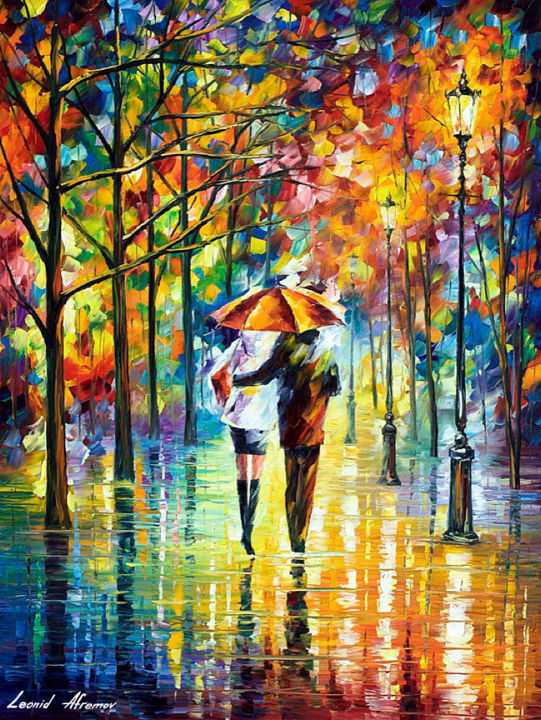by NICOLAS SARAZIN
Leonid Afremov was born into a family of shoemakers and metallurgical engineers in Vitebsk, Belarus, on July 12, 1955. He received a traditional Jewish education despite government practices. Leonid Afremov has knife painting in the Russian immigrant city of Ashdodq. He adapted to the taste of the public and worked in an alimentary way on acrylic.
An artistic career determined from his earliest childhood

Leonid Afremov was born into a family of shoemakers and metallurgical engineers on July 12, 1955 in Vitebsk, Belarus.
He received a traditional Jewish education despite anti-Semitic government practices.
At school, Afremov was a brilliant pupil whose main subjects were History and Art. Curious about everything, he attended every lesson opportunity at school. he notably took private lessons with renowned local artists, including Barowski.
Leonid graduated with honors from a local high school in 1973 and entered the Department of Arts and Graphics of the Vitebsk Institute of Education.
His first influences are great artists like Dali, Picasso, Modigliani and Chagall. During his university studies, Leonid Afremov participated in many exhibitions and began to sell some of his paintings. Their first son Dmitry was born the following year.
His first job was a label designer at a local spirits factory. Then, he worked briefly as a decorator in a theater. He started out in the early 1980s designing themed walls for various events, making propaganda posters for schools and communal farms, and creating model sculptures of Soviet politicians. It was a seasonal activity and Leonid Afremov spent the cold months painting at home. As he did not have access to government exhibitions and local art galleries due to his Jewish origin, most of his early paintings were sold through a private network and remained unknown. At the time, Afremov did not keep accounts of his personal production, and many of the paintings he created were lost between 1980 and 1990. In 1984, the family welcomed his second son Boris.
Exile and the discovery of your own style

The year 1990 marks a radical change in Leonid Afremov’s life when his family moved to Israel following the Khrushchev thaw. Thanks to the family he had in Ramat-Gan, he was able to find accommodation and soon afterwards find a job as a sign designer in a local advertising agency. Then he made frames in a gallery – a place where he had his first idea of knife painting. Due to the generally hostile attitude towards Russian immigrants in Israel, local galleries offered extremely low prices to purchase Afremov oil paintings. His attempts to sell at local exhibitions and art events also failed.
In the early 90s, Leonid Afremov painted mostly in watercolors and acrylics, and he almost didn’t use the palette knife. He adapted to the taste of the public and worked on food. Despite a new move to Slashdot, the city of Russian immigrants, Afremov did not find business opportunities there. He continued to accept low prices until his teenage son Dmitry tried to sell his works to his neighbors by going door to door. To his surprise, the idea turned out to be very lucrative. Many customers liked Afremov’s paintings, which helped them improve their living conditions.
In 1995, Leonid Afremov made enough money to open his own gallery in Ashdodq which did not appeal to locals. Israeli media refused to promote Afremov’s exhibits and the gallery was repeatedly vandalized. The artist had to advertise through Russian immigrant media and continued to exhibit his works in Russian community centers across the country. During this period he already devoted a lot of time to knife painting and began to develop his characteristic style. Before 2000, he befriended Leonid Ptashka, an Israeli jazzman who convinced Afremov to paint a series of portraits of great jazz musicians and helped him exhibit his collection successfully.
Afremov was successful but had to face a new ordeal: in 2001 his Ashdod gallery was completely destroyed. This event prompted Leonid Afremov to leave for the United States in search of a better future. He deliberately refrained from selling his works while still in Israel and therefore had over a hundred premium knife paintings for sale in New York City. American galleries have shown more hospitality and generosity. They agree to buy paintings by Afremov, but are mainly interested in portraits of musicians and Judaic motifs .


The post-2000s and global success Online
His son Boris decides to put his father’s works on the internet, and there his success becomes global very quickly.
Afremov’s oil paintings sell like hot cakes, and some customers were willing to pay a four-figure price.
For the first time in his life, Leonid Afremov had become a free artist, who sold in almost all countries.
The media publicized his art as stress-reducing art therapy. He appeared in various television shows and gained a reputation as a contemporary influencer artist.
He died on August 19, 2019 of cardiac arrest at his place of residence in Playa Del Carmen, Mexico. His children continue to distribute his works on the internet.

Source: https://www.artmajeur.com




